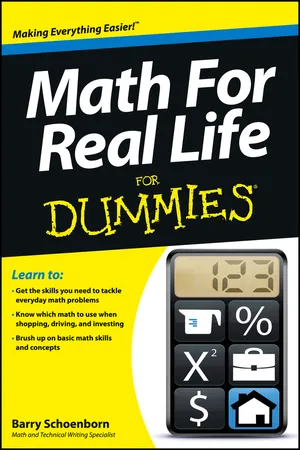Chapter 1
Awesome Operations: Math Fundamentals
In This Chapter
Reviewing the four arithmetic operations
Using charts to convey and understand information
Strategies to help you solve word problems
Math has basic operations that you need to know. These operations — addition, subtraction, multiplication, and division — make all the other math in this book possible.
The good news is that you most likely learned about basics (like counting) even before you entered school, and you learned about basic arithmetic operations in elementary school. So you’ve been at it for a long time.
In this chapter, I review counting and the fundamentals of the four basic arithmetic operations. Other important topics I cover here are fractions, percentages, charts and graphs, and word problems. But don’t worry: None of these are mysterious.
Numbers You Can Count On
The most fundamental component of math is numbers. The first thing you do with numbers is count, and you probably started counting when you were very young. As soon as you could talk, your mother cajoled you to tell Aunt Lucy how old you were or to count from 1 to 5.
Counting was the first and most useful thing you did with math, and you still use it every day, whether you’re buying oranges at the grocery store or checking the number of quarts of motor oil in a case.
Counting has been essential since people first walked the earth. In fact, the Ishango bone is a tally stick (a counting stick), and it’s over 20,000 years old!
Several kinds of numbers exist. Over time, mathematicians have given them many names. The two most important kinds are whole numbers and fractions. To see a little bit about how these numbers work, use a number line, a simple display of numbers on a line (see Figure 1-1).
Illustration by Wiley, Composition Services Graphics
Figure 1-1: A number line.
The numbers to the right of 0 are called natural numbers or counting numbers. Of course, they are the numbers you use to count. They’re easy for anyone to work with because they represent how many of something someone has (for example, 6 apples or 3 oranges).
Over many centuries and in different cultures, people made up the number 0, which represents the lack of a quantity. The numbers to the left of 0 on the number line, negative numbers, are a harder concept to grasp. You recognize negative number in real life. For example, if your checking account is overdrawn, you have a negative balance. If someone owes you $3.00, you have “negative cash” in your pocket.
Here are the key points to know about the number line:
All the numbers you see in
Figure 1-1 are
whole numbers, also called
integers. An
integer is a number with no fraction part. The word comes from Latin, and it means “untouched,” so it’s the whole deal.
The numbers to the right of zero are
positive integers. The numbers to the left of zero are
negative integers.
Mathematicians (and I’m not making this up) have trouble with zero. The best they can do is attach it to the positive integers and label the group
non-negative integers.
The number line stretches to the left and right, to infinity and beyond (as Buzz Lightyear says).
Decimals (such as 0.75) and regular fractions (such as 3/5) are only a part of a whole number. They all have a place somewhere on the number line. They fit in between the integers. For example 2.75 “fits” between 2 and 3 on the number line, because it’s greater than 2 but less than 3.
Reviewing the Four Basic Operations
To do any sort of math, you need to know your math basics. The four basic operations — addition, subtraction, multiplication, and division — let you take care of all kinds of real life math. But what’s also very important is that those same basic math operations allow you to handle fractions and percentages, which come up all the tim...












